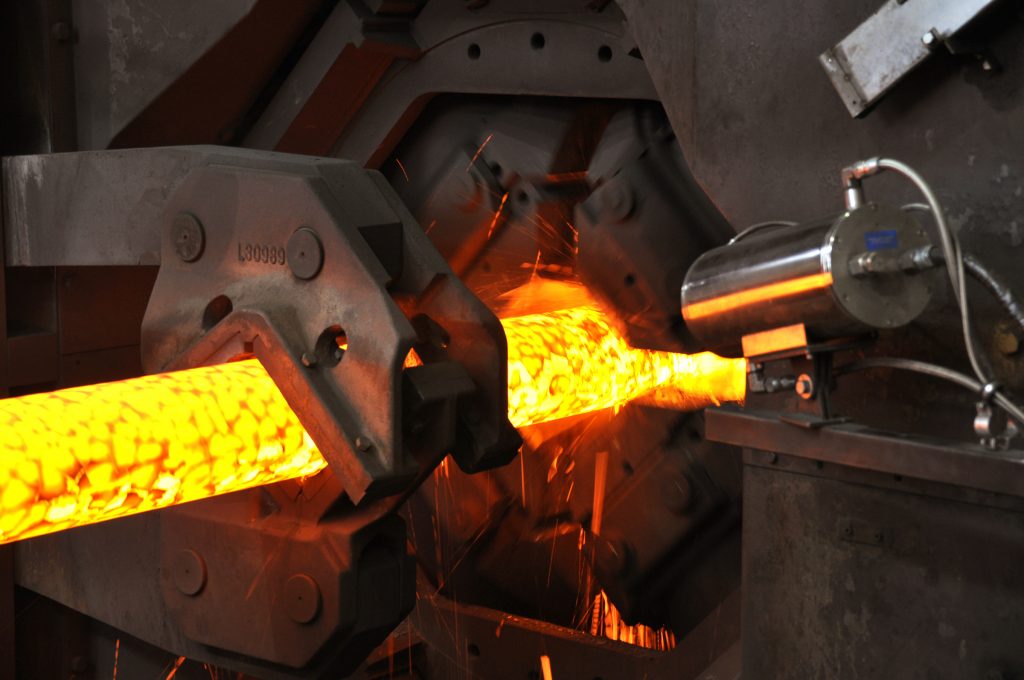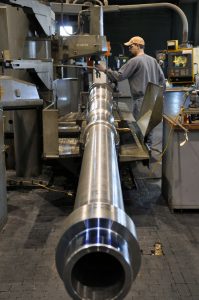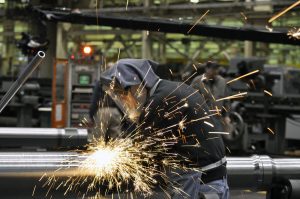White House Industrial Base Study Focuses On Near-Term Fixes
Posted on

A cannon barrel in the forge at Watervliet Arsenal, NY, the US Army’s only source of heavy gun tubes.
WASHINGTON: The defense industrial base study that President Trump ordered a year ago is nearing completion, a well-informed administration source told Breaking Defense. But the Executive Order 13806 study may come as a surprise: Instead of a sweeping agenda to restore America’s high-tech lead for future decades, the study will recommend near-term fixes to more mundane problems that could lose the US a war if one broke out tomorrow.
From aging facilities to imported supplies, the defense industrial base is full of potential chokepoints in the supply chain. A few examples:
- All the cannons on US Army armored vehicles come from a single aging facility, Watervliet Arsenal in New York — which was built in 1813.
- The US depends on imports for critical materials ranging from from beryllium to titanium sponge — many of which we buy from Russia, China, or the Central Asian “Stans.”
- Critical machine tooling is no longer made in the US but is imported primarily from Europe. While mostly friendly nations, few are unequivocal supporters of US military operations, so they might limit cooperation in a crisis where they disagreed with the US, as nations did in 2003 over Iraq.
These single points of failure already limit military modernization and potentially could disrupt operations in a crisis. That’s especially true if production needed to ramp up urgently for a major war, a subject the chairman of the Joint Chiefs of Staff, Gen. Joseph Dunford, has publicly angsted about.
Admittedly, none of these shortfalls has the scare factor or sex appeal of China overtaking the US in artificial intelligence or hypersonics. Those are two top priorities for the undersecretary of Defense for research & engineering, physicist, engineer, and businessman Mike Griffin. But while Griffin is looking 25 years out, the Section 13806 study is looking out five. And unlike AI and hypersonics, cannon barrels, beryllium-copper alloys, and machine tools are real and present needs right now.
Think of it in terms of the old nursery rhyme:
For want of a nail the shoe was lost.
For want of a shoe the horse was lost.
For want of a horse the rider was lost.
For want of a rider the message was lost.
For want of a message the battle was lost.
For want of a battle the kingdom was lost.
And all for the want of a horseshoe nail.
The E.O. 13806 industrial base study isn’t building any silver bullets for the US military — that’s Griffin’s job. Instead, it’s about building nails.
“I’m a big fan of Mike Griffin, but as much as we want to move into the Mike Griffin futuristic world, that’s not where we are,” the administration source told us. “We still have a primarily industrial-age military, with subcomponents that are made of steel and aluminum, sometimes even wood.”
Players & Process
Confounding many observers’ expectations, the 13806 study won’t particularly affect the big prime contractors like Lockheed Martin or Northrop Grumman, the source said. Instead, it traces the supply chain to second-, third-, and fourth-tier subcontractors across the US and around the word, looking for kinks in the hose. The detective work involved has been tremendous, and the process ponderous, with repeated delays.
At the top of the 13508 team is a partnership between controversial White House advisor Peter Navarro, known for his protectionist views, and Deputy Defense Secretary, former Boeing executive Patrick Shanahan, who’s pushing to Pentagon to implement the 2018 National Defense Strategy with its focus on great power competition.
The three primary programs that assist the industrial base — Defense Production Act Title III funds, the Industrial Base Analysis & Sustainment (IBAS) program, and the Manufacturing Technology Program (MANTECH) — are coordinated by the deputy assistant secretary of defense for manufacturing & industrial base policy (MIBP), Eric Chewning, a former Army intelligence officer and industry consultant.
It’s important to note that since the congressionally mandated split-up of the Acquisition, Technology, & Logistics (ATL) mega-bureaucracy, Chewning’s industrial base office reports to the undersecretary of Defense for acquisition & sustainment, Ellen Lord, who supports operations in the near term, rather than the undersecretary of research & engineering, Mike Griffin, who develops new technologies for the long term.
While the 13508 study team doesn’t seem to have reached out to many companies directly, in part for complex legal reasons, it has worked extensively with two major industry groups: the Aerospace Industries Association (AIA) and the National Defense Industrial Association (NDIA).
“We worked very heavily with them,” said NDIA president and retired Air Force Gen. Hawk Carlisle at an industrial base forum last month. Having spoken recently to both Lord and Chewning, Carlisle said that “they have the report done, it is in staffing. It was supposed to come out in May, (but) there are challenges getting it through the process.”
The delay is in part due to a desire to bring in agencies far outside the Pentagon. “They asked the entire US government from DoD to HHS to god-knows-who to plumb the bowels of their bureaucracy for how they might impact national security,” our source said. “A lot of these places don’t even have people with security clearances. They were taking people way out of their comfort zone.
“We’re trying to do a lot of muscle movements, in a short period of time, on a lot of things people are not used to doing,” the source summed up. “First of all, they’re identifying the gaps. Then they’re recommending how to fill the gaps. Then they’re trying to get the president to sign off on implementing the recommendations simultaneous to the release of the report.”
Currently, the report is almost finished, our source said — but it won’t be released right away. Briefers will probably first make the rounds on Capitol Hill, where there’s a longstanding ambivalence between the desire to help hometown companies and the fear of anything resembling industrial policy.
Industrial Policy?
Industrial policy tends to offend American sensibilities about government interference, and it’s had a mixed track record in practice anyway. But that debate may be shifting as China and Russia show what state-directed industries can achieve in a short time.
“Our competitors are well organized and we are not,” said Maj. Gen. John Jansen, commandant of the Eisenhower School (formerly the Industrial College of the Armed Forces) at National Defense University. “We’re talking about China now in particular taking the best of capitalism…. and they’ve harnessed it and they’ve made it work for them, still maintaining an authoritarian and some would say ever more ruthless society.”
Meanwhile in the US, “the great beacon of laissez-faire free market capitalism…. we’re not doing so good,” Jansen told last month’s NDIA forum. American industry is falling behind China and even Russia in a number of militarily important areas such as hypersonics and quantum computing, he warned. (And while Jansen didn’t say so aloud, “laissez faire” doesn’t even apply to much of the defense industry, which is closely managed by the Pentagon, especially shipyards). “What we’re doing right now, it’s not even laissez-faire, because laissez-faire applies to capitalism,” he said. “What we’re doing right now is incoherence.”
So the Eisenhower School is conducting its own study of the industrial base, reporting directly to Deputy Secretary Shanahan and Joint Chiefs Chairman Dunford. While the two studies are separate, Jansen and his team have consulted closely with Chewning and Navarro as they work on the 13508 study. The core of Eisenhower School project was a conference in late June with over 100 participants from across the federal government and from companies large and small, Jansen told the NDIA event last week.
While neither has yet been approved for release, the Eisenhower School study sounds more sweeping than the White House one. Besides increasing funding for the programs already in existence under Military & Industrial Base Policy, Jansen said, ideas under discussion include
- “a national security venture capital fund” the Pentagon can use to jumpstart innovative companies;
- “risk underwriting” by the federal government for key aerospace and defense investments by the private sector, much as the government already underwrites some US investments in high-risk countries overseas; or
- a UK-style “apprenticeship levy” that requires companies to spend a certain (small) percentage of their revenue on training new employees.
It all boils down, though, to “just one big decision,” Jansen said: “Are we going to organize…figure out what it takes to compete, (and) have an industrial base policy?” That’s profoundly counter-cultural for many Americans, he acknowledged. “You’re getting in the business of (sustaining) things that are economically non-viable,” he said. “People are going to rightfully start (asking), ‘is the federal government picking winners and losers?'”
But the same conservatives who object to government interference in other areas are often fervent supporters of a strong defense. “If you’re ever going to be able to have some semblance of industrial policy, it’s going to be in the national defense area,” the administration source said, “but we have to be smarter about how we do it.”
“Just doing that analysis was a worthy endeavor,” the source said of the 13508 study. “Now the policy question is, how many of those gaps that were identified does it make economic and strategic sense to plug? We’re going to have an interesting debate.”
Subscribe to our newsletter
Promotions, new products and sales. Directly to your inbox.








